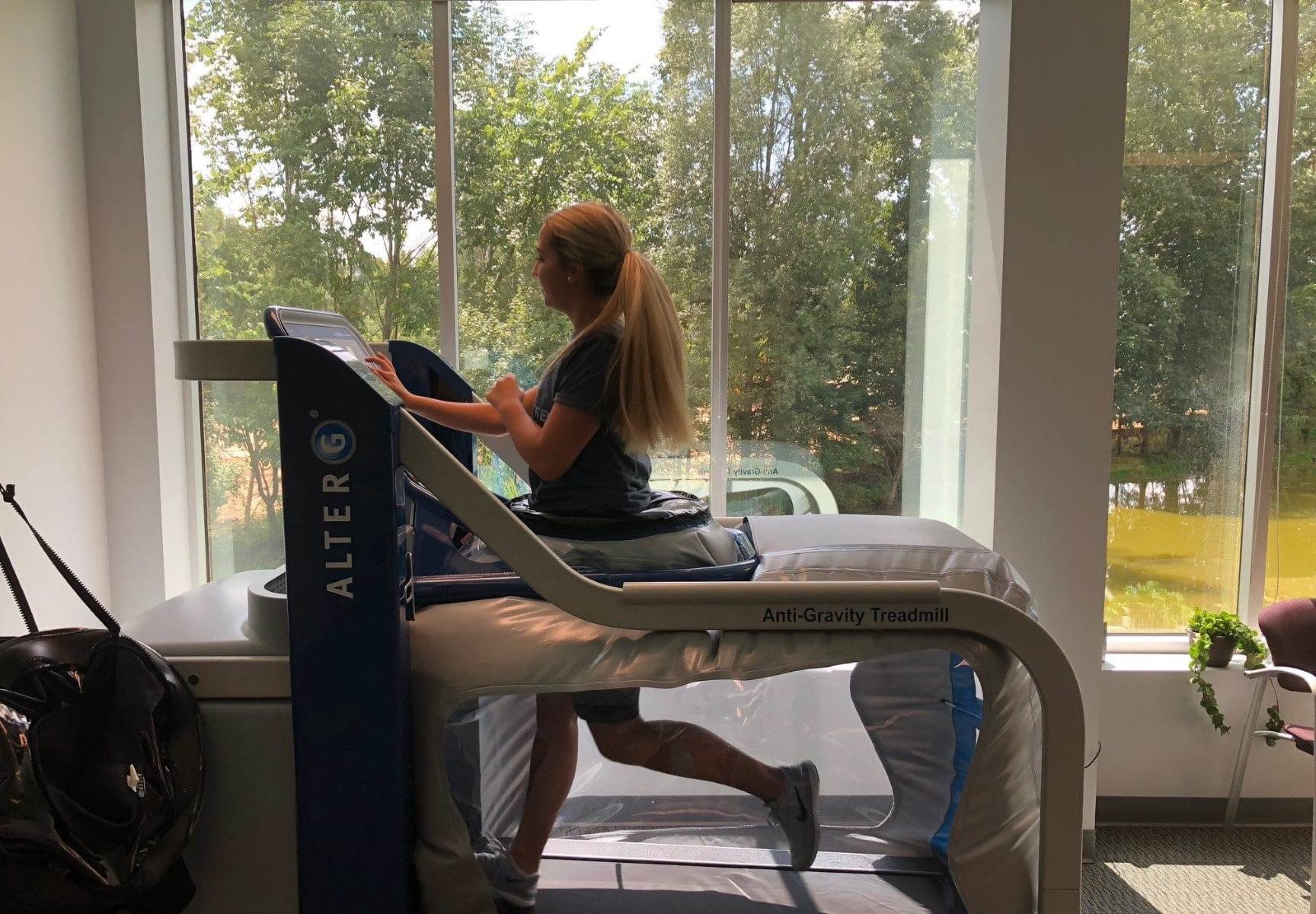Introduction
Welcome to the world of fitness and exercise! If you’ve been on a journey to improve your health and well-being, you’ve probably come across the term “weight-bearing exercise”. But do you fully understand what it means and why it’s important? In this article, we will explore the definition, benefits, examples, and incorporation of weight-bearing exercises into your fitness routine.
Weight-bearing exercise, also known as weight-bearing or resistance training, refers to any activity that requires you to support your body weight against gravity. It involves working against a resistance, whether that’s your own body weight, free weights, resistance bands, or machines. This type of exercise stimulates the bones, muscles, and connective tissues, and it has a multitude of benefits for your overall health.
So, why is weight-bearing exercise so crucial? Well, for starters, it is an effective way to build and maintain strong bones. This is especially important as we age because the risk of bone-related diseases, such as osteoporosis, increases. By engaging in weight-bearing exercises, you can improve bone density, reduce the risk of fractures, and promote overall bone health.
Weight-bearing exercise also helps to strengthen and tone your muscles. When you work against resistance, your muscles respond by increasing in size and strength. By incorporating weight-bearing exercises into your fitness routine, you can sculpt a lean and toned physique, improve your posture, and enhance your overall strength and stability.
In addition to physical benefits, weight-bearing exercise also has numerous mental health benefits. Regular exercise has been shown to reduce stress, improve mood, boost energy levels, and enhance cognitive function. Incorporating weight-bearing exercises into your routine can have a positive impact on your mental well-being, promoting a sense of accomplishment and boosting your overall quality of life.
Now that we understand the importance of weight-bearing exercise, let’s dive into some examples of exercises that fall into this category. From walking and jogging to strength training and yoga, there are plenty of options to choose from. Stay tuned for the next section where we explore these examples in detail and provide tips for incorporating them into your fitness regimen.
Definition of Weight Bearing Exercise
Weight-bearing exercise, also known as weight-bearing or resistance training, is a form of physical activity that requires you to support your body weight against the force of gravity. This type of exercise places stress on the bones, muscles, and connective tissues, contributing to their strength and overall health.
When engaging in weight-bearing exercise, you work against a resistance, which can be your own body weight, free weights, resistance bands, or machines. The resistance stimulates the muscles, prompting them to adapt and grow stronger over time. By challenging your muscles and bones through weight-bearing exercises, you can enhance their functions and reduce the risk of certain health conditions.
Weight-bearing exercise can take many forms, including but not limited to:
- Walking
- Running
- Jogging
- Dancing
- Aerobics
- Jumping rope
- Strength training
- Weightlifting
- Yoga
- Pilates
All of these activities require you to bear your own weight or work against an external resistance, thus engaging multiple muscle groups and improving bone density.
It’s important to note that weight-bearing exercise differs from non-weight-bearing exercise, such as swimming or cycling, where the body is supported or the force of gravity is reduced. While these activities provide cardiovascular benefits, they are not as effective in strengthening the bones and muscles as weight-bearing exercises.
Weight-bearing exercise is suitable for individuals of all ages and fitness levels. However, it’s important to consult with your healthcare provider or a qualified fitness professional before starting any new exercise program, especially if you have any pre-existing medical conditions or injuries.
Now that we have a clear understanding of what weight-bearing exercise entails, let’s delve into the various benefits it offers. Keep reading to discover how incorporating this type of exercise into your fitness routine can improve your overall health and well-being.
Benefits of Weight Bearing Exercise
Engaging in weight-bearing exercise provides a multitude of benefits for your overall health and well-being. Let’s explore some of the key advantages this type of exercise offers:
1. Increased Bone Density and Strength: Weight-bearing exercises place stress on the bones, stimulating the production of new bone cells and improving bone density. This is particularly beneficial for individuals at risk of osteoporosis or those looking to maintain strong bones as they age.
2. Enhanced Muscle Tone and Strength: Weight-bearing exercises challenge the muscles, leading to increased muscle strength and definition. By regularly engaging in these exercises, you can sculpt a lean and toned physique.
3. Improved Balance and Stability: Weight-bearing exercises not only strengthen the muscles but also enhance balance and stability. This can significantly reduce the risk of falls and related injuries, particularly in older adults.
4. Weight Management: Weight-bearing exercises are effective in burning calories and can aid in weight management or weight loss. The combination of strength training and cardiovascular exercise helps maintain a healthy body weight.
5. Reduced Risk of Chronic Diseases: Regular weight-bearing exercise can help reduce the risk of chronic conditions such as heart disease, diabetes, and certain types of cancer. It contributes to improved cardiovascular health, lower blood pressure, and enhanced insulin sensitivity.
6. Improved Mental Health: Weight-bearing exercise has a positive impact on mental well-being. It promotes the release of endorphins, known as “feel-good hormones,” which can reduce stress, anxiety, and symptoms of depression. Exercise can also improve sleep quality and boost overall energy levels.
7. Enhanced Functional Fitness: Engaging in weight-bearing exercises improves your ability to perform daily activities, such as lifting objects, climbing stairs, or carrying groceries. It enhances functional fitness, making your day-to-day life easier and more enjoyable.
8. Prevention of Age-Related Muscle Loss: As we age, we naturally experience a loss of muscle mass. Weight-bearing exercise can help slow down this process and preserve muscle strength and function, enabling older adults to maintain their independence and mobility.
These are just a few of the many benefits that weight-bearing exercise provides. Whether you’re a beginner or an experienced exerciser, incorporating weight-bearing exercises into your fitness routine can have a significant impact on your overall health and quality of life.
Now that we’ve explored the benefits of weight-bearing exercise, let’s move on to the next section, where we’ll discuss some examples of weight-bearing exercises that you can incorporate into your fitness regimen.
Examples of Weight Bearing Exercises
Weight-bearing exercises come in various forms, catering to different fitness levels and preferences. Here are some examples of weight-bearing exercises that you can consider incorporating into your fitness routine:
- Walking and Jogging: These simple yet effective exercises can be done outdoors or on a treadmill. By varying your pace and terrain, you can challenge your muscles and cardiovascular system.
- Running: Similar to walking and jogging, running is a high-impact weight-bearing exercise that boosts cardiovascular fitness and engages multiple muscle groups.
- Dancing: Whether it’s salsa, hip-hop, or ballet, dancing is a fun and dynamic weight-bearing activity that improves your coordination, flexibility, and cardiovascular health.
- Aerobics: Joining a group fitness class or following along with an online workout can provide a full-body aerobic workout, incorporating moves such as high knees, jumping jacks, and squats.
- Jumping Rope: Jumping rope is a fantastic cardiovascular exercise that also strengthens the muscles in your lower body, including your legs, glutes, and calves.
- Strength Training: Using free weights, resistance machines, or your own body weight, strength training exercises like squats, lunges, push-ups, and shoulder presses target specific muscle groups, promoting strength and muscle definition.
- Weightlifting: Whether you’re using barbells, dumbbells, or kettlebells, weightlifting exercises like deadlifts, bench presses, and bicep curls challenge your muscles and promote overall strength and power.
- Yoga and Pilates: While these activities may not appear to be traditional weight-bearing exercises, they still provide the benefits of weight-bearing exercise. The various poses and movements engage your muscles, helping to improve strength, flexibility, and stability.
Remember to start with exercises that are appropriate for your fitness level and gradually increase intensity and duration as you progress. It’s also important to ensure proper form and technique to prevent injuries.
Now that you have an idea of the different types of weight-bearing exercises, let’s move on to the next section, where we’ll discuss how you can incorporate these exercises into your fitness routine.
How to Incorporate Weight Bearing Exercises into Your Fitness Routine
Incorporating weight-bearing exercises into your fitness routine doesn’t have to be complicated. With a few simple steps, you can create a well-rounded exercise program that includes the benefits of weight-bearing exercise. Here are some tips to help you get started:
- Set Clear Goals: Determine what you want to achieve with your exercise routine. Whether it’s building strength, improving cardiovascular fitness, or toning your muscles, having clear goals will help you choose the right weight-bearing exercises.
- Choose a Variety of Exercises: Incorporate a mix of cardiovascular exercises, strength training exercises, and flexibility exercises into your routine. This will ensure that you target different muscle groups and enjoy a well-rounded workout.
- Start Slow and Gradually Increase Intensity: If you’re new to weight-bearing exercises, start with lighter weights and shorter durations. As your strength and fitness improve, gradually increase the intensity, duration, and weight to continue challenging your muscles and making progress.
- Include Both Compound and Isolation Exercises: Compound exercises, such as squats and lunges, involve multiple muscle groups and are great for overall strength and calorie burning. Isolation exercises, such as bicep curls and leg extensions, focus on specific muscle groups and can help sculpt and define those areas.
- Give Yourself Enough Rest: Rest days are essential for muscle recovery and growth. Schedule rest days in between weight-bearing exercise sessions to allow your body time to repair and rebuild muscle tissue.
- Listen to Your Body: Pay attention to how your body feels during and after each workout. If you experience any pain or discomfort, modify or reduce the intensity of the exercise. It’s important to prioritize safety and avoid overexertion.
- Find Accountability and Support: Whether it’s working out with a friend, joining a fitness class, or hiring a personal trainer, having someone to hold you accountable and provide guidance can greatly enhance your experience and motivation.
- Make It Enjoyable: Choose exercises that you enjoy and that align with your preferences and interests. If you find weight-bearing exercises fun and enjoyable, you’ll be more likely to stick with your routine and make it a long-term habit.
Remember, everyone’s fitness journey is unique, and it’s important to tailor your exercise routine to your individual needs and abilities. If you’re unsure about how to design an effective program, consider seeking guidance from a certified fitness professional or personal trainer.
Now that you have a better understanding of how to incorporate weight-bearing exercises into your fitness routine, it’s time to emphasize some precautions and considerations to ensure your safety and maximize the benefits of these exercises.
Precautions and Considerations for Weight Bearing Exercises
While weight-bearing exercises offer numerous benefits, it’s important to take certain precautions and considerations to ensure your safety and prevent injuries. Here are some key points to keep in mind:
- Consult with a Healthcare Professional: If you have any pre-existing medical conditions or injuries, it’s crucial to consult with a healthcare professional before starting a new exercise program. They can offer guidance tailored to your specific needs and help you determine what type and intensity of weight-bearing exercises are safe for you.
- Warm-up and Cool Down: Always warm up your muscles and joints before engaging in weight-bearing exercises. This can include five to ten minutes of light aerobic activity and dynamic stretches. Similarly, cool down with static stretches to help prevent muscle soreness and promote flexibility.
- Use Proper Form and Technique: Poor form and technique can increase the risk of injury. Take the time to learn and practice correct form for each exercise, and don’t hesitate to seek guidance from a qualified fitness professional if needed.
- Start with Appropriate Weight and Progress Gradually: When it comes to strength training exercises, choose weights that challenge you but still allow you to maintain proper form. Gradually increase the weight as your strength and technique improve, but always prioritize safety over ego.
- Listen to Your Body: Pay attention to any discomfort or pain during your workouts. If something doesn’t feel right, adjust your technique, decrease the intensity, or rest as needed. Pushing through pain can lead to further injury or setbacks.
- Allow for Adequate Rest and Recovery: Allow your muscles time to recover and rebuild by scheduling regular rest days. Aim for at least one to two days of rest per week, and prioritize sleep to support optimal recovery and muscle growth.
- Stay Hydrated and Fuel Your Body Properly: Hydration is essential for optimal performance and to prevent cramps and fatigue. Drink water before, during, and after your workouts. Additionally, fuel your body with a balanced diet that includes a variety of nutrients to support your energy needs.
- Modify Exercises for Any Limitations: If you have any physical limitations or injuries, work with a fitness professional to modify exercises to suit your needs. There are often alternative movements or equipment options that can help you safely engage in weight-bearing exercises.
By taking these precautions and considerations into account, you can minimize the risk of injury and maximize the benefits of weight-bearing exercises. Remember, always prioritize your safety and listen to your body.
In the final section, we’ll wrap up our discussion on weight-bearing exercises and summarize the key takeaways from this article.
Conclusion
Weight-bearing exercises are a vital component of any fitness routine, offering numerous benefits for your overall health and well-being. By engaging in activities that require you to support your body weight against gravity, you can improve bone density, enhance muscle tone and strength, boost cardiovascular fitness, and promote mental well-being.
Examples of weight-bearing exercises include walking, jogging, dancing, aerobics, strength training, weightlifting, yoga, and Pilates. It’s essential to choose a variety of exercises and gradually increase intensity to challenge your muscles and prevent plateauing.
When incorporating weight-bearing exercises into your fitness routine, remember to set clear goals, listen to your body, use proper form and technique, and prioritize rest and recovery. If you have any medical conditions or limitations, consult with a healthcare professional or certified fitness trainer for personalized guidance.
Incorporating weight-bearing exercises into your routine can have a positive impact on your bones, muscles, cardiovascular system, and mental health. It’s an investment in your overall well-being, allowing you to lead a more active, fulfilling, and healthy life.
So, lace up your sneakers, grab your weights, and get ready to embark on a journey of strength, health, and vitality through weight-bearing exercises. Whether you’re a beginner or an experienced exerciser, there’s a weight-bearing exercise out there for you. Remember, consistency and dedication are key, so start small and gradually build up your routine. Your body will thank you in the long run.
Now, it’s time to take that first step and start reaping the countless benefits of weight-bearing exercises. Good luck on your fitness journey!










